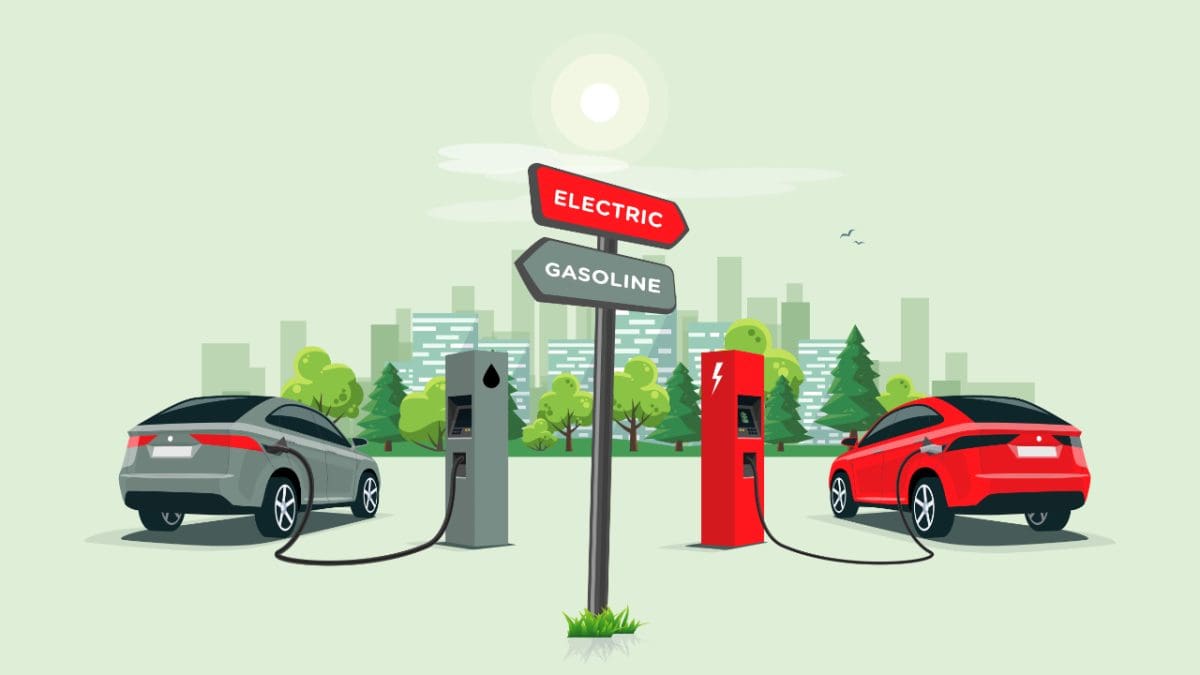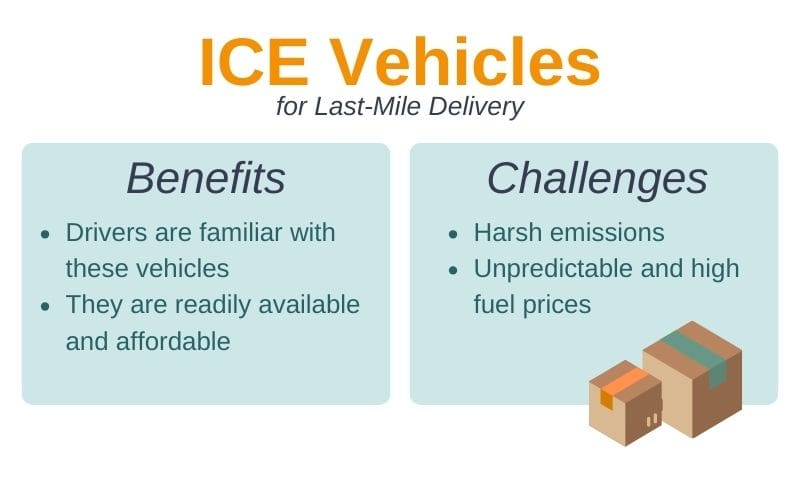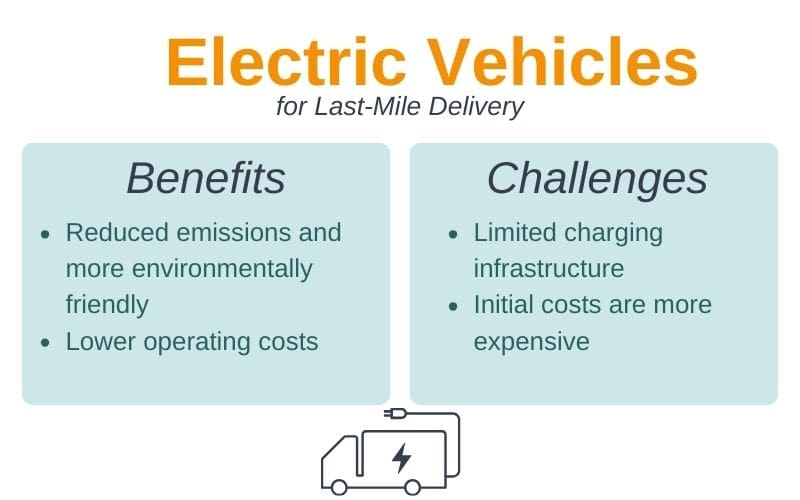
The world of last-mile delivery is indeed at a crossroads. For decades, Internal Combustion Engine (ICE) vehicles have been the stalwarts of delivery fleets, providing reliability and a wide range of options for various delivery needs. But, the landscape is rapidly changing, and Electric Vehicles (EVs) are emerging as a formidable challenger to the long-standing reign of ICE vehicles.
This shift is fueled by a combination of factors, including societal pushes for sustainability, advancements in battery technology, and increasingly stringent emissions regulations. While ICE vehicles offer the advantage of familiarity and a broad range of choices, they come with their own set of challenges, like environmental impact and fluctuating fuel costs. On the other hand, EVs promise lower operating costs and reduced emissions but face hurdles like limited charging infrastructure and higher upfront costs.
Today, we’re exploring an objective, comprehensive comparison to assist fleet managers in this crucial decision-making process. Whether you’re contemplating sticking with tried-and-true ICE vehicles or considering the switch to more eco-friendly EVs, this guide offers insights into the pros and cons of each option.
ICE Vehicles in Last Mile Delivery
Traditional Use
For many years, ICE vehicles have been the cornerstone of last-mile delivery operations. These vehicles have been around for over a century, and their mechanics and functionalities are well-understood. The infrastructure for ICE vehicles, including fueling stations and repair shops, is robust and widespread. This makes them a go-to option for businesses that require a reliable and readily available means of transportation for their delivery services.

Benefits
Familiarity
One of the most significant advantages of ICE vehicles is the familiarity that comes with them. Drivers often have years of experience operating these vehicles, and this experience can be invaluable in a last-mile delivery setting where time is of the essence. Mechanics, too, are well-versed in the ins and outs of ICE vehicles, making repairs and maintenance more straightforward and less time-consuming.
Availability
Another benefit is the sheer variety of ICE vehicles available on the market. Whether you need a compact van for urban deliveries or a larger truck for more substantial loads, you can easily find one. The wide range of options allows for greater flexibility in matching the right vehicle to specific delivery needs.
Challenges
Emissions
One of the most pressing challenges for ICE vehicles is their environmental impact. These vehicles emit a significant amount of greenhouse gases, contributing to climate change and air pollution. For businesses with sustainability goals, this is a considerable drawback.
Fuel Costs
Another challenge is the cost of fuel. Electricity costs are generally going down, while fuel prices can change a lot and be unpredictable. This unpredictability makes it challenging to forecast operational costs accurately. With fuel prices rising, this can severely impact the profitability of a last-mile delivery operation using ICE vehicles.
The Rise of Electric Vehicles
Growing Popularity
EVs are rapidly gaining ground in the realm of last-mile delivery. A societal shift towards sustainability and the promise of lower operating costs fuels this surge in popularity. As governments worldwide set ambitious targets to reduce carbon emissions, the adoption of EVs is growing. Companies are taking note, and many are beginning to incorporate electric options into their fleets as part of their corporate social responsibility initiatives.

Benefits
Reduced Emissions
One of the most compelling advantages of EVs is their environmental friendliness. Unlike their ICE counterparts, electric vehicles produce zero tailpipe emissions. For urban areas where air quality is a significant concern, this is a huge benefit. By adopting EVs, companies not only reduce their carbon footprint but also contribute to cleaner air.
Lower Operating Costs
Another advantage that’s hard to ignore is the potential for lower operating costs. Electricity is generally cheaper than gasoline, and EVs often require less maintenance than ICE vehicles. There are fewer moving parts, which means fewer things can go wrong. This translates to less frequent repairs and lower maintenance costs over the vehicle’s lifetime. A study by Consumer Reports in 2020 found that the average lifetime maintenance and repair expenses for an EV are about 3 cents per mile, which is half the cost for gas-powered vehicles. Newer electric vehicles, which require less upkeep, are even more cost-effective, costing an average of just 1 cent per mile for maintenance.
Challenges
Infrastructure
The road to widespread EV adoption isn’t without its bumps. One of the most significant challenges is the current state of charging infrastructure. While charging stations are becoming more common, they’re still not as widely available as traditional gas stations. This can pose logistical challenges for fleet managers who need to plan routes carefully to ensure that vehicles can be charged when needed.
Initial Costs
The upfront costs of EVs are also a hurdle. While prices are gradually coming down, electric vehicles generally have a higher initial purchase price compared to ICE vehicles. This can be a deterrent for smaller companies or those with tight budgets. Still, it’s important to consider the total cost of ownership, which often favors EVs when fuel savings and lower maintenance costs are taken into account. Plus, many EV automakers are making a commitment to avoid future price wars.
Cost Effectiveness: ICE vs EV
The debate between ICE vehicles and EVs often boils down to cost-effectiveness, a critical factor for any fleet manager. Both types of vehicles present a unique set of financial considerations that can significantly impact the bottom line.
ICE Vehicles
ICE vehicles generally come with lower upfront costs, making them an attractive option for businesses on a tight budget or those looking to quickly expand their fleet. But, this initial saving can be deceptive. ICE vehicles typically have higher fuel costs, and the volatile nature of fuel prices can make budgeting a challenge. Maintenance expenses can also accumulate over time, from oil changes to exhaust system repairs, adding to the total cost of ownership.
Electric Vehicles
In contrast, EVs usually have a higher initial purchase price, which can be a barrier to entry for some businesses. But, they tend to offer long-term financial benefits that can offset the initial investment. Electricity costs are usually lower and more stable than fuel prices, and EVs often require less maintenance due to fewer moving parts. Over the lifespan of the vehicle, these savings can add up, making EVs a cost-effective choice in the long run.
Environmental Impact: ICE vs EV
Emissions and Air Quality
When it comes to environmental impact, the differences between ICE vehicles and EVs are stark. ICE vehicles are notorious for emitting carbon dioxide (CO2), nitrogen oxides (NOx), and particulate matter, all of which contribute to poor air quality and climate change. In urban areas, where last-mile delivery is most prevalent, these emissions can exacerbate health issues like asthma and other respiratory conditions.
On the flip side, EVs offer a much cleaner alternative. They produce zero tailpipe emissions, significantly reducing the carbon footprint of last-mile delivery operations. This is particularly beneficial in densely populated areas where improving air quality is a pressing concern. By switching to electric vehicles, companies can play a pivotal role in mitigating environmental pollution.
Sustainability
While it’s true that both ICE and electric vehicles have environmental impacts, including the resources needed for manufacturing and eventual disposal, EVs have a clear advantage when it comes to aligning with sustainability goals. Many EVs are designed with recyclable materials, and the electricity that powers them can be sourced from renewable energy. This makes EVs a more sustainable choice in the long term, especially as the energy grid becomes increasingly green.
Companies that adopt electric vehicles often gain reputational benefits. Consumers are becoming more eco-conscious, and a green fleet can serve as a strong selling point. This aligns with corporate social responsibility initiatives and offers a competitive advantage in the market.
Practical Considerations
When evaluating the suitability of ICE vehicles and EVs for last-mile delivery, practicality is key. These factors often serve as the tipping points in the decision-making process for fleet managers.
Range
One of the most discussed aspects is the range that a vehicle can cover on a single tank of fuel or a full charge. ICE vehicles have historically had the upper hand in this regard, capable of covering long distances without the need for refueling. This has made them a preferred choice for routes that extend beyond urban and suburban areas.
On the other hand, EVs have been playing catch-up. While the range of electric vehicles has significantly improved over the years, it still generally falls short compared to ICE vehicles. For urban deliveries where distances are shorter, this limitation isn’t such a big deal.
Charging Infrastructure
Another practical consideration is the availability and convenience of refueling or charging infrastructure. Gas stations are everywhere, making it easy to refuel ICE vehicles quickly. EVs face challenges here, as charging stations aren’t as widespread. Plus, charging an electric vehicle takes longer than refueling an ICE vehicle, which could be a logistical issue for fleets that operate around the clock.
Payload Capacity
Payload capacity is another factor that fleet managers need to consider. ICE vehicles, particularly larger models, often offer higher payload capacities, allowing for more goods to be transported per trip. This can be a significant advantage for businesses that deal with bulky or heavy items. Electric vehicles are improving in this aspect, but they often still lag behind ICE vehicles, especially when the additional weight of batteries is considered. Heavier cargo reduces the range an EV gets on a single charge.

The Decision-Making Process
The choice between ICE vehicles and EVs for last-mile delivery is far from straightforward. It involves a multi-faceted decision-making process that goes beyond just initial costs or environmental impact. Fleet managers must weigh a variety of factors, each with its own set of advantages and challenges.
- Cost: This includes not just the upfront purchase price but also long-term operational costs, such as fuel or electricity and maintenance.
- Environmental impact: Environmental goals are increasingly becoming a key consideration, especially for companies looking to align with sustainability initiatives or meet regulatory requirements.
- Operational needs: Needs like vehicle range, payload capacity, and the availability of refueling or charging infrastructure, also play a significant role. These factors can greatly influence the efficiency and reliability of your delivery operations.
- Flexibility and adaptability: These are crucial in this decision-making process. Market conditions, technological advancements, and even regulatory landscapes can change, affecting the pros and cons of each option. Being able to adapt to these changes is vital for making the most informed, long-term decision for your fleet.
The decision between ICE and EV is complex and should be made after careful consideration of multiple factors. What works best will depend on the unique needs and goals of your operation.
The Future of Last-Mile Delivery
The landscape of last-mile delivery is poised for significant changes in the coming years, and the debate between ICE vehicles and EVs is at the forefront of this evolution. Several key factors are set to shape the future of this sector.
- Battery technology: Advancements in battery technology are a game-changer. As batteries become more efficient, cheaper, and quicker to charge, the range and cost-effectiveness of EVs are expected to improve, potentially leveling the playing field with ICE vehicles.
- Charging infrastructure: The charging infrastructure is also rapidly evolving. The increasing availability of fast-charging stations will make it easier for fleet managers to integrate EVs into their operations, reducing one of the key barriers to adoption.
- Regulations: As governments worldwide ramp up efforts to combat climate change, stricter emissions standards are likely to be implemented. This could tip the scales further in favor of electric vehicles, making them not just an environmentally responsible choice but potentially a legal necessity as well.
Technological advancements and changing regulations will continue to influence the ICE vs EV debate, making it essential for fleet managers to stay informed and adaptable to navigate the evolving landscape successfully.
Navigating the Complex Choice: ICE vs EV for Last Mile Delivery
The decision to opt for ICE vehicles or EVs isn’t a black-and-white choice but rather a nuanced decision that requires a deep understanding of your specific operational needs, long-term business goals, and even societal responsibilities.
Given the rapidly evolving landscape of last-mile delivery, staying informed and adaptable is crucial. Whether it’s keeping an eye on emerging technologies, understanding changing regulations, or calculating the total cost of ownership, each aspect plays a significant role in making the most informed choice for your fleet.
For a more tailored analysis and insights specific to your operational needs, don’t hesitate to contact Elite EXTRA. Our expertise can provide you with the tools and information you need to navigate this complex decision-making landscape successfully.
Sources
https://www.arenaev.com /ice_v_ev__differences_and_similarities-news-185.php
https://medium.com /@Electricvehicles.in/differences-between-electric-vehicles-ice-vehicles-c7a1934bc719
https://www.nerdwallet.com /article/loans/auto-loans/ev-total-ownership-costs
https://electrek.co /2023/07/06/ev-automakers-tesla-nio-pledge-avoid-price-wars-china/
https://blog.marketresearch.com/the-thriving-market-for-electric-vehicles-in-last-mile-delivery







